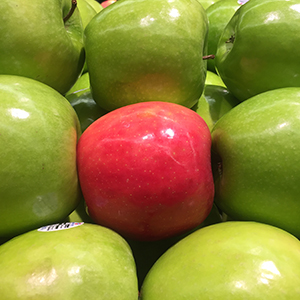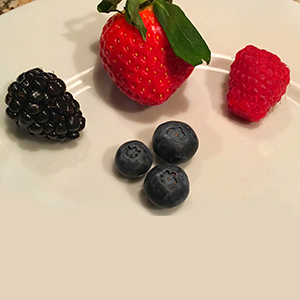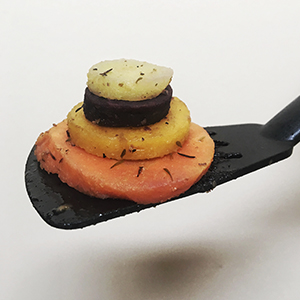You probably know that experts believe a healthy diet includes a rainbow of colors. But, when it comes to food and nutrition, does color matter? Take this quiz to find out. Answer yes or no and scroll down to see if color makes a food healthier.
Does food color make a difference?
- Bell Peppers – Green, Orange, Red and Yellow
- Eggs – Brown and White
- String Beans – Green, Purple and Yellow
- Wine – Red and White
- Bread – Brown and White
- Bananas – Green and Yellow
- Baby Potatoes – Brown, Purple and Red (skin)
- Pasta – Brown, Green, Orange and White
- Apple – Green and Red
- Cauliflower – Orange, Purple, White and Yellow
- Berries – Black, Blue and Red
- Carrots – Orange, Purple and Yellow
- Sugar – Brown and White
- Asparagus – Green and White
- Grapes – Green and Red
- Rice – Brown and White
- Onions – Red, Yellow and White
Answers
1. Yes
Red peppers are the most nutritious and sweetest because they have been on the vine the longest. Green peppers are harvested earlier before they have a chance to turn yellow, orange or finally red. Red peppers have tons more beta-carotene and almost twice the vitamin C over their less sweet green pepper sibling.
2. No
Most people think brown eggs are healthier than white, but the difference is miniscule. The reason for the color difference is simple genetics. Chickens with white feathers lay white eggs and chickens with brown feathers lay brown eggs. There are lots more white eggs in the markets because chickens with white feathers don’t eat as much as their counterpart; thus, they are cheaper to raise!
3. No
However, be warned, while the yellow ones will maintain their color after cooking, the purple ones typically fade to green once cooked.
4. Yes
Red wine also has more antioxidant qualities and less sugar than white wine. Nothing has to be done to make red wine healthy. Its powerful antioxidants and low-calorie density make it one of the best choices for adult beverages.
5. Yes
This should be an easy one. The flour in white bread is more highly processed than that in whole wheat (brown) bread. During processing, the germ and bran of the wheat grain are removed, leaving only the part of the grain with the least nutrients.
6. Yes
Bananas are different on the inside too. Did you know there’s a big variation in the sugar content between green and yellow bananas? As they ripen, bananas increase in sugar so if you are controlling your insulin level or sugar intake stick to greener ones.
7. No
Nutritionally, the purple and red skinned potatoes are comparable to other varieties of white-fleshed potatoes. It is what’s on the inside that matters when it comes to both nutrition and taste with potatoes.
8. Yes
Use whole wheat or whole grain pasta, it’s worth it, I promise. This may not seem like much of an improvement but switching to wheat (brown) helps prevent insulin spikes that occur with white pasta. The wheat/grain version contains triple the fiber content, which means it will be digested slower and keep you fuller longer.
9. Yes
If you can get used to the slightly sour taste of the greens, you can expect more health benefits! Most people prefer red apples because of how sweet they are. Green apples contain a higher amount of nutrients and less sugar than their red friends. Either way, be sure to eat the skin, that’s where all the fiber is.
10. No
The orange and purple cauliflower are only slightly higher in antioxidants than regular white cauliflower. The colorful varietals may look different than the popular white cauliflower, but the taste is just the same.
11. Yes
This one is easy because they don’t even look alike. Since many use colors in their names, I included berries in the quiz for fun. Do you know which of these berries has the highest percentage of Vitamin C? Strawberries! One cup contains a whopping 149% of your RDA for Vitamin C. Blackberries and Raspberries are about 50%, followed by Blueberries at just 24%.
12. Yes
Rainbow carrots deliver different nutrients with each color. Popular orange carrots are higher in beta-carotene, purple carrots have more anthocyanin, white carrots are great sources of fiber and yellow carrots contain more lutein.
13. Yes
Slash added sugars. We all want to avoid eating too much, but it’s not easy. I don’t agree with completely removing any food from the diet, so I just try to make healthier choices when I can. The difference between white and brown sugar is just that the brown version contains molasses. Since molasses contains small amounts of protein, vitamins and minerals, it’s a slightly better choice than its pure white counterpart.
14. Yes
While there are some differences in nutrients, the big differences are in taste. White asparagus is grown underground so no light hits it. The light is what turns the most common variety green. White asparagus is slightly sweeter and more delicate tasting than its green cousin. Purple asparagus has a bit of a fruity flavor to it and tastes delicious raw. It also has more sugar than green or white asparagus and a lower amount of fiber.
15. Yes
Just like wine, red grapes are better for you than white (green) grapes. The darker a grape’s skin, the more phytonutrients it contains. Brightly colored fruits contain larger amounts of antioxidants than their less colorful counterparts.
16. Yes
Brown again is the winner over white. While neither rice is known for its nutritional value, brown rice is a whole grain so it contains some fiber and several vitamins and minerals. The white rice refining process removes these parts.
17. Yes
The differences go beyond appearance and taste. Purple onions are the most nutritious because they contain a higher amount of antioxidant compounds than their less colorful siblings. Yellow onions are next and white onions tend to have the least amount in the onion family. Still white onions have plenty of health benefits and include more fiber and a higher amount of sulfur than other onions.















